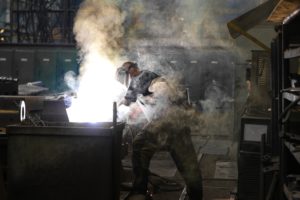American Made, Iron Clad Protected - Discover the Industries Best Warranty.
Blog
The use of different types of materials in different high heat industrial applications
https://www.pexels.com/photo/rocket-factory-256297/
It’s not a piece of cake to manage a high heat industrial site. This is why inspections are mandatory.
Regular inspections of industrial areas keep all the safety precautions in check. However, these inspections are useless if you’re unaware of the right protocol.
High heat industrial sites use different kinds of materials, depending on the nature of the need. You’ll find out about these materials along with their right application, installation, and inspection techniques. With this knowledge, you’re on the right track for successful inspections!
Types of materials used by high heat industrial applications
You may think you already know about the different materials used in high heat industrial applications. However, the truth is that with technology advancing at such a steady pace, there’s always something more to learn.
The following items and materials are generally the most beneficial in various high heat industries.
Sealants
Industrial machinery usually doesn’t come as one piece. It has to be assembled by putting together multiple small parts. These parts tend to have small gaps. This feature isn’t safe in high heat environments. This is why heat resistant sealants need to be added to your inspection list. Other than that, sealants are also used to fill in cracks or leaks that may have appeared on machines or other surfaces.
Heat resistant sealants stay strong in up to 1500 Fahrenheit temperature. They come in two forms. The liquid foam sealants can be used for machines whereas the cement sealants work perfectly for bigger surfaces.
These sealants can cope with the steadily rising temperature and pressure in industrial areas. They do not shrink or expand much. Moreover, these sealants serve as a shock and vibration absorber too.
Welding blankets
A huge number of industrial sites conduct welding at their location. High heat cutting and brazing are also common. This is usually done manually so the person doing the job is at a high risk of getting hurt. Not only is welding and brazing risky on its own, but when it’s done at high temperatures, the molten metal has more dangerous tendencies.
The best way to prevent fumes and metal splashes is to use welding blankets. These welding blankets serve as a safety shield between the worker and the material that is being cut or welded. It’s recommended to get welding blanket rolls so that one product can be used in multiple locations within one industrial site at once.
These welding blanket rolls provide a welding blanket for all situations. They can be used as insulation pads, valve covers, heat shields, and so much more. This product is made out of silica yarn, fiberglass, and carbonized felt material. All these materials are a strong protection against any sort of molten metal splashes, fumes, and heat.
Welding blankets are also used to cover machines that can heat up to harmful temperatures. These blankets keep the heat controlled and prevent the surrounding area from catching fire.
Fire sleeves
There’s hardly any industrial site that doesn’t have the installation of wires, cables, or vents. The problem is that these wires, hoses, and other similar items aren’t very heat-resistant. So, in high heat locations, they can be protected using fire sleeves.
Fire sleeves are an insulating sheet made out of fiberglass and silicone. It’s an SAE approved item. Fire sleeves themselves can bear a temperature of up to 540 degrees Celsius. However, they keep the wires underneath protected from any sort of heat.
Not only are fire sleeves great for heat protection but they also keep these wires away from oil, water, and other chemicals that may be found on site. You can choose between various sizes and lengths as per the need of your industrial location.
Heat-resistant tape
A lot of industrial sites need a binding tape. It may be needed to cover up pipes, tag certain machines, or to stick things together. In high temperatures, the normal tape can melt. It loses its sticky properties. Certain tapes may even catch fire.
This is where heat resistant tapes come in. These tapes have various properties that suit industrial sites, specifically ones where high temperature is experienced.
The heat resistant tape stays strong despite the consistent rise in temperature. It doesn’t expand as much as regular tape so it will not come off. Moreover, it’s resistant to water, chlorine, salt, and dryness. You can find multiple options within the category of heat resistant tapes.
For example, one type comes with a heavy coating of iron oxide so it works ideally with fiberglass. Similarly, there are options of width, color, thickness, etc.
Rotary baking ovens
One extremely high heat situation that most people tend to ignore is commercial kitchens. The ovens in there go up to a temperature of 400 Fahrenheit on average. For the safety of the personnel and to produce quality food, rotary baking ovens are necessary.
There’s an FDS guideline to use ovens that have used carbon graphite alloy material in production. This material is self-lubricating so there’s no dripping lubricant. Also, this material can withstand high temperatures. Therefore, it’s the best option to use for long-term continuous movement to keep the temperature controlled without the need of possibly harmful lubricants.
Board dryer bearings
Industries that produce plywood, ceiling tiles, gypsum board, and other similar products need drying ovens to finish off these products. These ovens heat up to 1100 Fahrenheit on average.
The produced products are placed at multiple levels within the oven. Each level has rollers that are supported by bearings to make it easy to load and unload the ovens. Generally, similar bearings will need lubricants to maintain the smooth rolling of the heavy boards. Plus, these lubricants will keep the bearings strong against high temperatures.
However, lubricants aren’t convenient or ideal for these ovens. That’s why graphite bearings should be used. They don’t require any lubricating agent. Besides, they can withstand high temperatures and weight for long periods.
The takeaway
All these materials work well for varying situations. Make sure to add these items to your inspection list so that you can maintain the high safety of your industrial site. By doing so, you’ll not just minimize the risk factor, but you’ll also increase the reputation of your industrial site.
Having an inspection list all set will bring you a long list of advantages in the longer run. This short-term hassle is worth it and something that you should never skip!
Recent Posts
- 7 Common Mistakes to Avoid When Setting Up Machine Guarding Fences
- Industrial Curtain Walls: 6 Reasons Why Manufacturing Facilities Must Have Them
- Industrial Soundproof Curtains: How to Decide Between Floor-Mounted and Ceiling-Mounted Curtains
- How to Transform a Noisy Open-Plan Office with Acoustic Baffles
- A Guide to Choosing the Best Concrete Blanket for Construction Projects
- Porch Curtains: 8 Amazing Reasons to Install These Curtains in Your Home
- Chemical Splash Curtains and Their Applications in Different Industries
- Outdoor Sound Curtains for Farms and Animals
- Construction Sound Barriers: Why Every Construction Site Should Have These?
- Industrial Blackout Curtains and Their Applications in Different Settings
Categories
- Accordion Fold Curtains
- Acoustic Baffles
- Agri-Shield Curtains
- Auto Body Shop Curtains
- Bio Plastics
- Industrial Divider Curtains
- Industrial Safety Products
- Insulated Curtain Walls
- Machine Guard Safety Fencing
- Mesh Curtain Screens
- Outdoor Curtains
- PVC Strip Curtains
- Soundproof Noise Blocking Curtains
- Spray Paint Booth Curtains
- Tarps
- Thermal Curtains & Covers
- Uncategorized
- Warehouse Dividers
- Welding Blankets
- Welding Curtains
- Welding Screens




